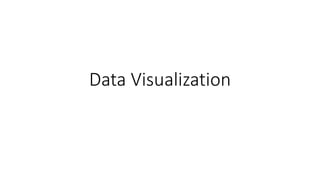
Data Visualization concept for beginners
- 2. Graphics to Visualization Data visualization is a crucial aspect of conveying complex information in a comprehensible and meaningful way. Here are some key graphics and visualization concepts from the field of data visualization theory: 1. Data Types: 1. Quantitative Data: Numerical data that can be measured and expressed with numbers (e.g., height, weight). 2. Categorical Data: Descriptive data that represents categories or labels (e.g., colors, types of fruits). 2. Visual Encodings: 1. Position: The placement of data points along a common scale, such as a bar chart's height or scatter plot's x and y coordinates. 2. Size: Using the size of visual elements to represent quantities, like in a bubble chart. 3. Color: Assigning colors to different categories or representing values on a spectrum. 4. Shape: Differentiating data points by using distinct shapes (e.g., different markers in a scatter plot). 3. Charts and Graphs: 1. Bar Charts: Displaying data using rectangular bars of varying lengths. 2. Line Charts: Connecting data points with lines to show trends over time. 3. Pie Charts: Representing parts of a whole using slices of a circle. 4. Scatter Plots: Displaying individual data points in a two-dimensional space.
- 3. 1.Principles of Design: 1. Simplicity: Keep visualizations simple, avoiding unnecessary clutter to enhance understanding. 2. Clarity: Ensure that the message is easily understood, using clear labels, legends, and annotations. 3. Accuracy: Represent data truthfully and avoid misleading visualizations. 4. Relevance: Include only relevant information to support the intended message. 2.Color Theory: 1. Color Palette: Choose a suitable color palette, considering factors like accessibility, contrast, and color associations. 2. Color Scales: Use appropriate color scales (e.g., sequential, diverging, categorical) depending on the data being visualized. 3.Interactivity: 1. User Interaction: Allow users to interact with visualizations through filters, tooltips, and dynamic elements. 2. Drill-Down: Enable users to explore detailed information by drilling down into specific aspects of the data.
- 4. 1.Storytelling: 1. Narrative Flow: Arrange visualizations in a logical sequence to guide viewers through a story. 2. Annotations: Use annotations to highlight key points or provide additional context. 2.Dashboard Design: 1. Layout: Organize visualizations in a clear and cohesive layout, considering the flow of information. 2. Consistency: Maintain a consistent design style, color scheme, and labeling across visualizations. 3.Gestalt Principles: 1. Proximity: Group elements that are close to each other. 2. Similarity: Use similar visual properties for related items. 3. Continuity: Create smooth and continuous patterns for better perception. 4.Accessibility: 1. Contrast: Ensure sufficient contrast for readability, especially for individuals with visual impairments. 2. Alternative Text: Provide alternative text for images and charts to assist screen readers. •
- 5. Rendering Basics and Texture mapping 1.Rendering Basics: 1. Modeling: Define the geometry of the objects you want to visualize. In data visualization, this could represent 3D representations of data points or structures. 2. Lighting: Consider the lighting conditions to create realistic shading effects. This is particularly important for highlighting features in 3D visualizations. 3. Camera Perspective: Define the viewpoint and perspective of the virtual camera to control how the scene is viewed. 4. Rendering Engines: Utilize rendering engines or libraries (such as WebGL, Three.js, or Unity) to facilitate the rendering process. 2.Texture Mapping: 1. Texture Coordinates: Associate points on a 3D surface with corresponding points on a 2D texture map. 2. Texture Images: Apply images or patterns to the surfaces of 3D objects to enhance realism. 3. UV Mapping: The process of translating 3D geometry into 2D texture coordinates, allowing textures to be accurately applied to the surfaces. 4. Bump Mapping and Normal Mapping: Techniques to simulate surface details by perturbing normals or simulating bumps without modifying the underlying geometry.
- 6. 1.Data-Driven Textures: 1. Color Mapping: Use textures to represent additional data dimensions, such as color variations based on data values. 2. Heatmaps: Apply gradient textures to represent intensity or density variations in data. 2.Interactive 3D Visualization: 1. User Interaction: Implement controls for users to manipulate and explore 3D visualizations. 2. Zoom and Pan: Enable users to zoom in and out or pan across the 3D space to focus on specific details. 3. Rotation: Allow users to rotate the 3D scene for different perspectives. 3.Performance Considerations: 1. Optimization: Optimize rendering performance, especially when dealing with large datasets, by implementing techniques like level-of-detail (LOD) rendering. 2. WebGL and GPU Acceleration: Leverage WebGL or other GPU-accelerated technologies for efficient rendering in web applications.